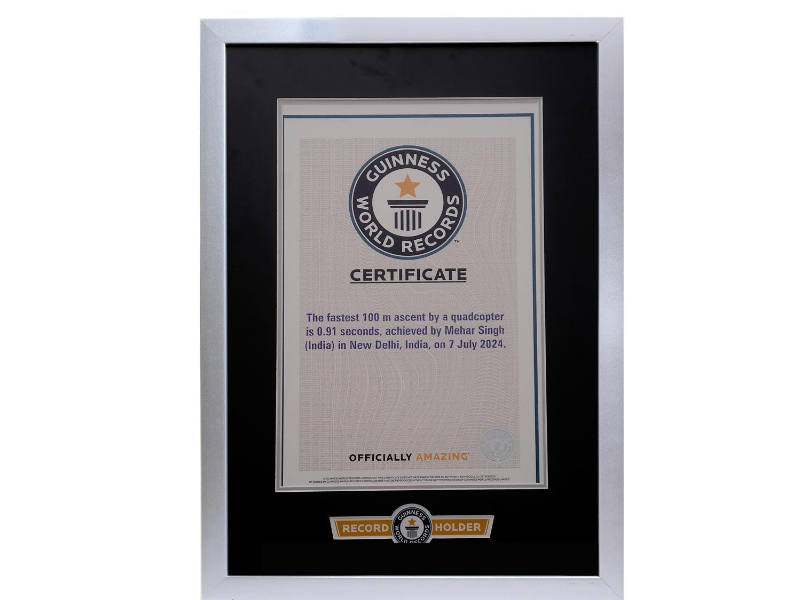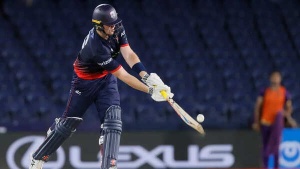At the young age of 17, Mehar Singh has etched his name in the annals of technology by achieving a new Guinness World Record. He accomplished the fastest 100-meter ascent with a quadcopter. Singh’s specially designed drone completed the feat in a mere 0.91 seconds, a testament to his engineering skills and a significant advancement in drone technology.

Singh's path to this achievement was fueled by a long-standing fascination with drones that began in the 8th grade. Driven by a desire to push technological limits, he spent months developing a drone capable of unprecedented vertical acceleration.
"I've always been captivated by the idea of exploring the boundaries of drone capabilities," Singh stated. "Breaking a world record was not just about the end result; it was about the journey. I aimed to demonstrate the extraordinary potential of current technology, but the path was fraught with challenges."
The project demanded that Singh design, test, and refine numerous drone prototypes. "There were times when I questioned the feasibility of my dream," Singh admitted. "I went through countless designs, many of which failed during testing. Some crashes were so severe that I had to return to the drawing board. Each setback, however, sparked new ideas and innovations."

Unfazed by these obstacles, Singh dedicated his efforts to creating a drone that was not only fast but also aerodynamically sound. "I invested numerous hours in CAD software, carefully designing and adjusting each component. The objective was to make the drone as streamlined as possible, which led me to adopt a rocket-like shape. This design was not just about aesthetics; it was about minimizing drag and maximizing speed."
Singh's commitment to his craft resulted in a spectacular success. "Every failure offered a valuable lesson," he said. "It compelled me to think creatively and meticulously consider every detail, from the materials used to the weight distribution of the drone. The process was demanding, but it was also incredibly rewarding to see my ideas take flight."

This record-breaking achievement holds substantial implications for the future of drone technology. "The possibilities are endless," Singh reflected. "High-speed vertical acceleration could revolutionize fields ranging from emergency response to space exploration. This isn’t just about setting a record; it’s about unlocking new innovations and applications."
Singh’s achievement has inspired others in the drone community and beyond. “I hope this accomplishment encourages other young innovators to push their own boundaries,” he said. “Technology is advancing rapidly, and there’s so much potential waiting to be unlocked. I’m excited to see where we can go from here.”
As Mehar looks ahead, his potential is limitless. With his record-breaking drone, he has not only made history but has also paved the way for future advancements in drone technology. For this young innovator, this achievement marks just the beginning of his exciting journey into the future of flight.
Newer articles
Older articles
 Smith Eyes Grenada Test Return After Injury Recovery
Smith Eyes Grenada Test Return After Injury Recovery
 Google Maps Boosts Navigation Precision with Fused Orientation Provider Update
Google Maps Boosts Navigation Precision with Fused Orientation Provider Update
 Earth Sciences Minister Rijiju Expresses Frustration Over Atos Supercomputer Delay, Jeopardizing Weather Forecast Upgrades
Earth Sciences Minister Rijiju Expresses Frustration Over Atos Supercomputer Delay, Jeopardizing Weather Forecast Upgrades
 Washington Freedom Snatch Last-Ball Win Over Knight Riders in MLC Thriller; Playoff Hopes Soar
Washington Freedom Snatch Last-Ball Win Over Knight Riders in MLC Thriller; Playoff Hopes Soar
 East Africa Rift: Mantle Upwelling Drives Birth of New Ocean, Study Finds
East Africa Rift: Mantle Upwelling Drives Birth of New Ocean, Study Finds
 Colon Cancer: Don't Ignore These 5 Subtle Warning Signs
Colon Cancer: Don't Ignore These 5 Subtle Warning Signs
 Prasidh Krishna Vows to Sharpen Bowling After Costly Leeds Performance
Prasidh Krishna Vows to Sharpen Bowling After Costly Leeds Performance
 Gavaskar Urges India to Replace Thakur with Yadav for Second Test Against England
Gavaskar Urges India to Replace Thakur with Yadav for Second Test Against England
 Rishabh Pant's Unconventional Batting Style Is Revolutionizing Cricket, Says Greg Chappell
Rishabh Pant's Unconventional Batting Style Is Revolutionizing Cricket, Says Greg Chappell
 Vitamin B12 Deficiency: Cardiologist Explains Symptoms, Sources, and Why You're Always Tired
Vitamin B12 Deficiency: Cardiologist Explains Symptoms, Sources, and Why You're Always Tired